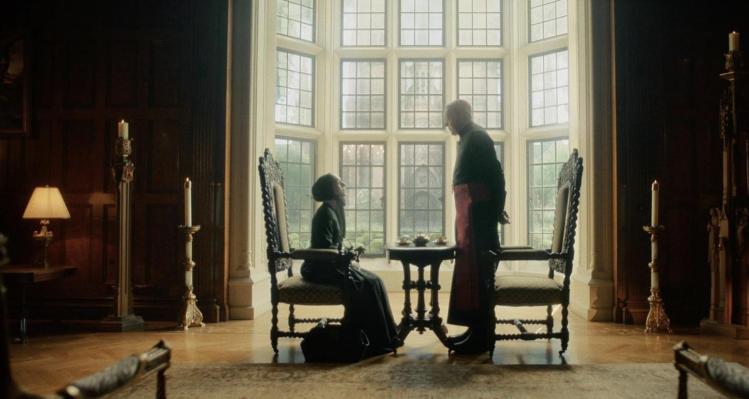
“They oughta send them all back.”
“A wave of brown-skinned filth.”
“Keep your crime and your filth out of this neighborhood.”
This is some of the invective directed at Mother Frances Xavier Cabrini after she arrives in a chaotic New York City, as depicted in the luminous new film drama Cabrini—and it should be obvious that the kind of abuse that bigots hurled at this future saint and her fellow Italian immigrants in 1889 is also freely applied to migrants today.
“Filthy dagoes, they just keep coming,” one gent tells the just-off-the-boat sister. “Who you looking at, guinea-pig?”
It’s a good historical rendering of Cabrini’s jarring welcome to New York; the scenes echo correspondence in which she wrote home requesting additional habits and veils for her sisters, “otherwise they will call us ‘guinea-pigs’ the way they do to the Italians here.” (“Guinea” was a slur used against Black people, the coin used to purchase slaves.)
The time is right for a new biopic of Mother Cabrini, the patron saint of immigrants and the first American citizen to be canonized. From Donald Trump on down, many politicians are pushing antipathy for migrants to boost their election campaigns. I see the result in my own Brooklyn neighborhood, where efforts to help migrants at a local shelter are treated on social media with expressions of anger and sarcasm.
As Pope Francis has said, Cabrini’s life is of “extraordinary current relevance, because migrants certainly need good laws, development programs, and organization, but they also always need, first and foremost, love, friendship, and human closeness; they need to be heard, to have people look into their eyes, to be accompanied; they need God.”
The new film, produced by Angel Studios and directed by Alejandro Monteverde, finds this space and presents a much-needed message of compassion with great visual and emotional impact. It’s a traditional underdog story, with a physically frail, five-foot-tall sister in the Rocky role fighting against the system. The Italian actress Cristiana Dell’Anna, who starred in the HBO Max crime drama Gomorrah, brings a fiery determination to her portrayal of Cabrini.
I had some doubts about whether this team would do justice to the story. Since Utah-based Angel Studios heavily markets its films and fundraising pitches to a conservative Christian audience, I wondered if Cabrini would really present the saint’s pro-immigrant fervor at a time when conservative politicians are exploiting anti-immigrant sentiment. That’s not to stereotype Evangelicals; many Christian groups have aided migrants, as Scripture demands, and some think a more Bible-based response is beginning to take hold. But overall, for example, nearly three-quarters of the white Evangelical Protestants interviewed in a PRRI survey would “favor installing deterrents to prevent immigrants from entering the country illegally even if they endanger or kill some people.”
Director Monteverde’s previous film for Angel Studios, last year’s box-office hit Sound of Freedom, has been lauded for spotlighting the evils and prevalence of child sex-trafficking, but was criticized because “the film could be seen as adjacent to the alt-right paranoia that was originally stoked by 4Chan and QAnon” on this subject, as Variety put it. Monteverde and the film's screenwriter responded in the Hollywood Reporter that the script was written in 2015, well before these conspiracy theories were spread, and that it “was not in the least political.”
But promotion for Sound of Freedom, aided by a special showing for Trump at his estate in Bedminster, N.J., was politicized. That was highlighted when lead actor Jim Caviezel, best known for playing Jesus in Mel Gibson’s The Passion of the Christ, announced on Fox & Friends that voting for Trump was the way to take action against the trafficking of children for sex. “This is the new Moses,” he said of Trump as he was interviewed along with the movie’s producer, the Mexican actor and political activist Eduardo Verástegui, who has similarly marketed his movies with a political slant.
Don’t expect Trump to embrace and promote Cabrini in the way he did Sound of Freedom. It contradicts his anti-immigrant agenda. In the opening scene, for example, employees at a hospital turn away a young boy trying desperately to get care for his sick mother, remarking that Italian immigrants were “monkeys” and “inferior.” It shows in shorthand the influence of the racist eugenic theory that was popular at the time, and which Trump is trying to revive by claiming that immigrants are “poisoning the blood of our country.”
When I spoke with the director, the executive producer, and the screenwriter in separate interviews, all said that Cabrini was not political: it’s not about immigration policy, but about immigrants. That’s true. But with Trump and right-wing media trying to persuade the public that migrants are a horde of criminals, the core Christian value of compassion toward strangers has become suspect. Organizations that welcome the immigrant, such as Catholic Charities, are facing political pushback from Republican politicians and even some right-wing Catholic groups.
In the film, Cabrini bases her embrace of immigrants on a Biblical mandate: “For at the hour of our death, we will be asked just one question,” the future saint says. “What did we do for the poor, the homeless?”
Is it too much to hope that this film, with its beautiful cinematography and strong performances, will pack the emotion needed to change some hearts and minds?
The movie’s origin story goes back to the late Sr. Mary Louise Sullivan, formerly president of Cabrini College (now University) and author of the excellent history, Mother Cabrini, ‘Italian Immigrant of the Century.’ She had pestered a producer she knew to do a new movie about Cabrini, recalled Sullivan’s friend Sr. Christine Marie Baltas.
“I said, ‘Sister, I don’t even want to do another movie,’” executive producer Eustace Wolfington told me. But Wolfington, a Catholic businessman who has long had a devotion to Mother Cabrini and a great appreciation for her entrepreneurial savvy, changed his mind.
Monteverde told me that his first reaction to Wolfington’s pitch was that, “Well, how do you make a movie about a nun entertaining?” But as he read the screenplay by Rod Barr (also the screenwriter for Sound of Freedom), “I was like, oh wow, this woman is a force of nature…. I felt her life was very cinematic.”
Cabrini is reasonably historical, although there is plenty of license taken for the sake of drama. It captures the spirit of its remarkable heroine. Dell’Anna’s performance powerfully shows how sickly Cabrini was; respiratory illnesses and fever plagued her since childhood, as did (as the film depicts) the memory of nearly drowning at the age of seven. “The biggest challenge for her was not only that she was a woman, but a dying woman,” Monteverde said.
The film is accurate in showing how Church authorities initially gave Cabrini the cold shoulder. When New York’s Archbishop Michael Corrigan (David Morse) first meets her after she arrives from Italy, he refers to the “Italian problem,” a phrase American bishops used to describe the influx of Catholics from Italy.
Corrigan tries to order her to return to Italy; Cabrini holds her ground by reminding him that Pope Leo XIII (Giancarlo Giannini) had sent her on this mission. Corrigan then orders Cabrini to limit her fundraising—she wants to open an orphanage—to the Italian community, knowing full well that there was little money to be had there.
It’s historically accurate, and the bias Cabrini faced in the Church went even further than shown in the movie. After the Jesuit superior rebuffed her request for help, she wrote, “But, alas! He was more than Irish, that is to say for nothing was he disposed to help the Italians.”
If Cabrini had not stood up to the powerful men who frequently towered in her path, she would never have opened dozens of schools, hospitals, orphanages, convents, and other institutions. Corrigan may come across as somewhat more the heavy than he was, however. They eventually worked well together; correspondence shows that Cabrini tried to assure the archbishop, who was embattled by controversy, that he was appreciated in Rome.
Cabrini speaks powerfully about the role of women in the Church and society at large. This was in fact a concern for Mother Cabrini, who was invited to speak at the first National Women’s Conference, held in Rome in 1908. The film shows how Cabrini deftly handled the men who posed obstacles to her plans for her order, the Missionary Sisters of the Sacred Heart: Mother Cabrini was simply far more competent than the men who were in control, and more determined.
This is showcased in a key scene in which Cabrini intervenes on the floor of the Italian Senate to seek support for the impoverished Italian emigrants in America. I didn’t think this was historical, and asked Barr where it came from. He told me that he picked up on it from an oral tradition among the sisters when he went to do research at the Cabrini Museum in Codogno, Italy. He also found some documentary evidence for it in a 1931 Italian newspaper article about the memoir of a socialist legislator who’d written that Cabrini had walked into the Italian government headquarters years earlier “with ease as if she were at her own home” to urge continued funding for an emigration commission that subsidized her work.
There is a major conflict in the film between Mother Cabrini and a fictitious New York “Mayor Gould.” It’s not historical, but it does allow for a peppy performance from John Lithgow as the mayor who refers to the diminutive sister as “some puffed-up dago nun.” There are other fictitious touches of drama, such as when New York police detain Cabrini.
Cabrini does not examine the spiritual wellspring of Mother Cabrini’s love for immigrants—her deep devotion to the Sacred Heart of Jesus. In a way that seems very modern, she combined contemplation—on what Pope Benedict XVI has called “the mystery of the heart of a God who feels compassion and who bestows all his love upon humanity”—with innovative social action. The historical record shows that she did, in fact, share in the prejudices that northern Italians had for immigrants from the country’s south. But her constantly renewed decision to love led her to the people on the periphery: not only to marginalized immigrants in New York, New Orleans, Chicago, Seattle, and other U.S. cities, but into Central American jungles, deep into mines where Italian workers labored, into prisons, hospitals, classrooms, and church basements. She’s a saint we need, and Cabrini makes her story live.


